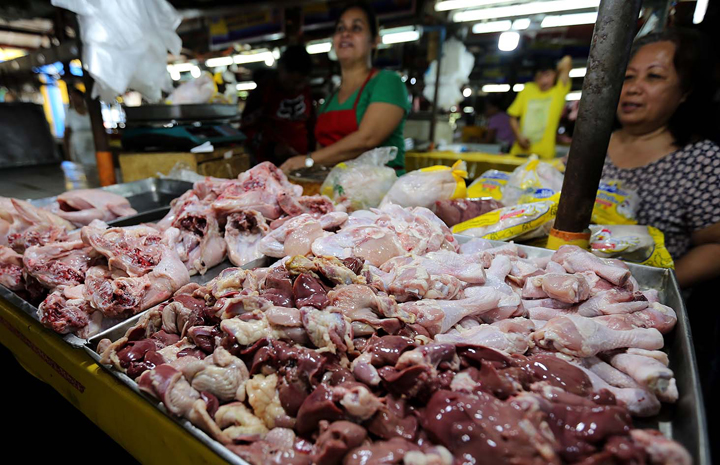
THE Philippines will continue to rely on food imports to meet the projected domestic demand by 2030, according to the latest report released by the Organization for Economic Co-operation and Development and Food and Agriculture Organization (OECD-FAO).
In the OECD-FAO Agricultural Outlook 2021–2030 report, it is projected that the Philippines will increase its purchases of rice, pig meat, and poultry.
The report noted that with global GDP in 2030 projected to remain below prepandemic estimates, a business-as-usual path will also make achieving the Sustainable Development Goal (SDG) 2 on zero hunger by 2030 “particularly challenging.”
“The challenges of eradicating hunger will vary among countries. According to the Outlook, average global food availability per person is projected to grow by 4 percent over the next 10 years, reaching just over 3,025 kcal [kilocalories]/day in 2030,” the report stated.
“Consumers in middle-income countries are projected to increase their food intake most significantly, while diets in low-income countries will remain largely unchanged.”
GDP, incomes
The report stated that global GDP is expected to rebound in 2021-2022 and grow at an average rate of 2.9 percent over the next 10 years.
While the world economy is projected to recover to pre-Covid-19 levels by 2022, countries in Southeast Asia and India could recover by 2021 and 2022, respectively.
OECD-FAO also estimated that after contracting 6 percent in 2020, global per capita income is expected to recover in 2021 and 2022.
Over the coming decade, the report said an average annual growth rate of 1.9 percent in real terms is projected.
Further, strong growth is expected in Asia, with per capita income increasing by 5.8 percent per annum (p.a.) in India and 5.3 percent p.a. in China.
“Growth in per capita income is also expected to be strong in Vietnam, at 5.5 percent p.a. over the coming decade, and in the Philippines, Indonesia and Thailand at 4.7 percent, 3.8 percent and 3.6 percent p.a., respectively,” the report stated.
OECD-FAO said food consumption will be significantly affected by population and demographic changes as well as incomes and income distribution.
“The Outlook assumes that food demand will be additionally shaped by sociocultural and lifestyle-driven changes in consumption patterns, including continuing urbanization and rising female participation in the workforce, as well as increasing consumer awareness of health and sustainability issues,” the report said.
These factors, the report said, will determine the size of the consumer population, the composition of food baskets, and their ability to purchase these commodities.
Consumption, imports
Based on the report, the country’s rice consumption per capita is expected to increase to 129 kilograms (kg) per person by 2030 from an annual average estimate of 120.3 kg per capita between 2018 and 2020.
The report noted that per capita consumption of rice will slow to 0.29 percent annually between 2021 and 2030. This is slower than the 0.49 percent annual per capita increase recorded between 2011 and 2020.
With this, the country’s total rice consumption will increase to 18.249 million metric tons (MMT) by 2030. This is 19.81 percent higher than the annual average consumption of 15.232 MMT between 2018 and 2020.
However, the report estimated that rice imports will increase to 3.549 MMT by 2030. This is 29.9 percent higher than the annual average of 2.732 MMT posted between 2018 and 2020.
Nonetheless, rice production is expected to increase to 14.738 MMT by 2030. This is 18.08 percent higher than the annual average production of 12.481 MMT between 2018 and 2020.
“In addition to China and Nigeria, the group of five major importers in 2030 will include the Philippines, the Islamic Republic of Iran, and the European Union. This group is expected to account for 22 percent of global rice imports by 2030, compared to 23 percent in the base period,” the report said.
Meanwhile, in terms of pig meat, the report projected that the country’s consumption will eventually slow to 11.2 kilogram retail weight equivalent per capita (kg rwe/cap) by 2030 from the annual average of 13 kg rwe/cap between 2018 and 2020.
With this, total consumption is expected to slow to 1.774 MMT by 2030 from the annual average of 1.796 MMT between 2018 and 2020.
However, production is expected to decline to 1.483 MMT carcass weight equivalent (cwe) by 2030 from the annual average of 1.671 MMT cwe between 2018 and 2020.
With this, OECD-FAO said the imports of pig meat are projected to increase to 293,000 MT cwe by 2030 from the annual average of 128,000 MT cwe in the 2018 to 2020 period.
The growth of imports could average 7.13 percent annually between 2021 and 2030, more than twice the 3.15 percent annual average recorded between 2011 and 2020.
“The increase in pigmeat production will remain limited in the first three years of the Outlook due to the slow recovery from the outbreaks of ASF in China, the Philippines and Viet Nam,” the report stated.
“The recovery process is assumed to be completed by 2023, especially in China, supported by the rapid development of large scale production facilities that can ensure biosecurity,” it added.
Meanwhile, per capita poultry consumption could increase to 16.3 kg rwe/cap by 2030 from an average of 13.7 kg rwe/cap during the 2018 to 2020 period.
This means that poultry meat consumption in the country could reach 2.287 MMT ready to cook (rtc) from the average of 1.687 MMT rtc between 2018 and 2020.
Poultry meat production could increase to 1.557 MMT rtc by 2030. This is higher than the 1.373 MMT rtc average recorded between 2018 and 2020.
With this, the country’s poultry meat imports could increase to 731,000 MT rtc by 2030. This is significantly higher than the average of 315,000 MT rtc posted in the 2018 to 2020 period.

